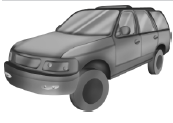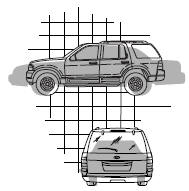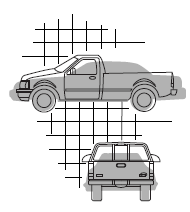Wheels and Tires
GENERAL INFORMATION
Notice to Utility Vehicle, Van and Truck Owners
WARNING: Utility vehicles have a significantly higher rollover rate than other types of vehicles. To reduce the risk of serious injury or death from a rollover or other crash you must:
• Avoid sharp turns and abrupt maneuvers;
• Drive at safe speeds for the conditions;
• Keep tires properly inflated;
• Never overload or improperly load your vehicle; and
• Make sure every passenger is properly restrained.
WARNING: In a rollover crash, an unbelted person is significantly more likely to die than a person wearing a seat belt.
All occupants must wear seat belts. Children and infants must use appropriate restraints to minimize the risk of injury or ejection.

Utility vehicles, vans and trucks handle differently than passenger cars in the various driving conditions that are encountered on streets, highways and off-road. Utility vehicles, vans and trucks are not designed for cornering at speeds as high as passenger cars any more than low-slung sports cars are designed to perform satisfactorily under off-road conditions.
Four-Wheel Drive System (If Equipped)
WARNING: Do not become overconfident in the ability of four-wheel drive vehicles. Although a four-wheel drive vehicle may accelerate better than a two-wheel drive vehicle in low-traction situations, it will not stop any faster than two-wheel drive vehicles.
Always drive at a safe speed.
A vehicle equipped with four-wheel drive (when selected) has the ability to use all four wheels to power itself. This increases traction which may enable you to safely drive over terrain and road conditions that a conventional two-wheel drive vehicle cannot.
Power is supplied to all four wheels through a transfer case or power transfer unit. Four-wheel drive vehicles allow you to select different drive modes as necessary. You can find information on transfer case operation and shifting procedures in the Transmission chapter. You can find information on transfer case maintenance in the Maintenance chapter.
You should become thoroughly familiar with this information before you operate your vehicle.
On some four-wheel drive models, the initial shift from two-wheel drive to four-wheel drive while the vehicle is moving can cause a momentary clunk and ratcheting sound. These sounds are normal as the front drivetrain comes up to speed and are not cause for concern.
How Your Vehicle Differs from Other Vehicles

Sport-utility vehicles, vans and trucks can differ from some other vehicles in a few noticeable ways.
Your vehicle may be:
• Higher – to allow higher load carrying capacity and to allow it to travel over
rough terrain without getting hung up or damaging underbody components.
• Shorter – to give it the capability to approach inclines and drive over the crest
of a hill without getting hung up or damaging underbody components. All other things
held equal, a shorter wheelbase may make your vehicle quicker to respond to steering
inputs than a vehicle with a longer wheelbase.

• Narrower – to provide greater maneuverability in tight spaces, particularly in off-road use.
As a result of the above dimensional differences, sport-utility vehicles, vans and trucks often will have a higher center of gravity and a greater difference in center of gravity between the loaded and unloaded condition.
These differences that make your vehicle so versatile also make it handle differently than an ordinary passenger car.
- Tire care
- Using snow chains
- Tire Pressure Monitoring System (TPMS)
- Changing a road wheel
- Technical specifications
See also:
Personal Safety System
The Personal Safety System provides an improved overall level of frontal crash
protection to front seat occupants and is designed to help further reduce the risk
of airbag-related injuries. The sy ...
Roadside Assistance
Vehicles sold in the U.S. : Getting roadside assistance
To fully assist you should you have a vehicle concern, Ford Motor Company offers
a complimentary roadside assistance program. This program is ...
Driver and passenger airbags
WARNING: Never place your arm or any objects over an airbag module. Placing
your arm over a deploying airbag can result in serious arm fractures or other injuries.
Objects placed on or over the ai ...
